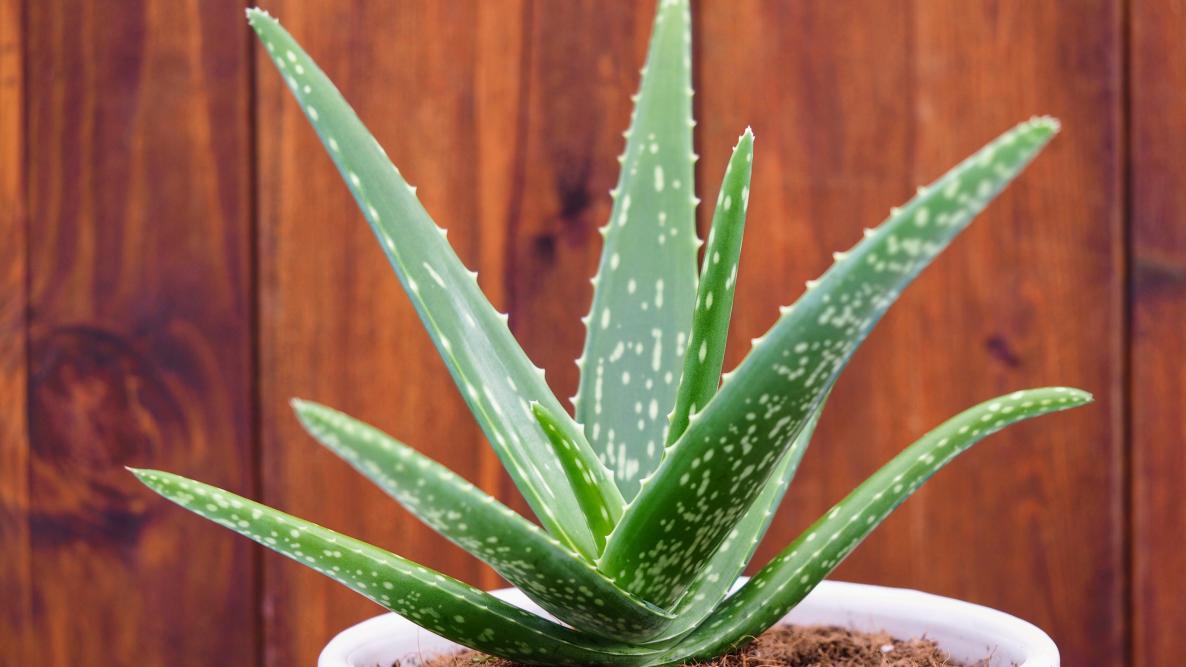Aloe-vera
∙ Scientific name: Aloe elongata
∙ Common name: Kanda
∙ Family: Asphodelaceae
∙ Ever green, perrenial plant, used in medicines, ointments.
Diseases of aloevera :-
Aloe Rust :-
Phakopsora pachyfhiza and P. meibomiae
Symptoms :-
∙ Aloe rust is a fungal infection that invades leaf structure and forms hard, blackened spots. ∙ The good news is that this condition does not kill the plant, and new growth will not show signs of the rust. Most aloes lose their leaves as they grow. When they fall off, throw them in the trash.
∙ Many plant species can serve as hosts for these fungi. Some have built up immunity, while the aloes, haworthias and gasterias have not. The spores of the fungi are carried by the wind and can travel a long distance. The conditions that favor infection are extended periods of leaf wetness and a temperature range of 60 to 82 degrees F. Temperatures above 86 degrees prevent development of the disease.
∙ Spores are produced 10 days after infection and released about three weeks after that. As long as the environment is moist with moderate temperatures, spores will be generated.
∙ There are some ways to prevent aloe rust from occurring. First is to not let water stay on the leaves. Good air circulation can help keep leaves dry. Get rid of any leaves that you have cut off or have fallen off as soon as possible.
∙ Dust plants with sulfur powder every one to two weeks. This will not kill the rust, but will prevent germination of new spores. Spray a solution of one teaspoon of baking soda in one quart of water to help fight the rust. Foliar fungicides may also help. In one article, the author recommended using copper oxychloride.
∙ Small, pale yellow spots on leaves which expand and turn brown; orange spore masses may be present on underside of leaf; leaves may drop from plant.
Management :-
Disease is self limiting and requires no treatment.
Anthracnose : Colletotrichum gloeosporiodes
Symptoms :-
∙ The initial appearance of small round to oval
∙ dark green water-soaked which later become circular spots with tan to light brown center.
∙ As the spots mature the center of the lesion become reddish brown to brown color. ∙ With progress in disease the lesions join together to form big necrotic area.
Management :-
Application of suitable fungicides.
Bacterial soft rot : Pectobacterium chrysanthemi
Symptoms :-
∙ Watery,
∙ rotting leaves which are darker in color;
∙ young leaves wilting and collapsing;
∙ leaves bulging due to gas formation inside.
Management :-
Fatal disease; avoid over-watering plants.
Sooty Mold :
∙ Symptoms :-
∙ Sooty mold is a fungal infection that is secondary to an infestation of aphids or mealy bugs.
∙ Aphids and mealy bugs are pests that suck moisture out of plants, and leave a clear, sticky substance called honeydew behind on the leaves.
∙ The honeydew creates a moist atmosphere, which eventually develops into sooty mold.
∙ Sooty mold is a fungal infection that is secondary to an infestation of aphids or mealy bugs.
∙ Aphids and mealy bugs are pests that suck moisture out of plants and leave a clear, sticky substance called honeydew behind on the leaves.
∙ The honeydew creates a moist atmosphere that eventually develops into sooty mold. Sooty mold does not kill the plants; the insects will do that.
∙ To address sooty mold, wash off the honeydew. This substance can be hard and lessen the amount of light reaching the leaves, reducing photosynthesis.
Basal Stem Rot :-
∙ Symptoms :-
∙ Basal stem rot is the result of cold or wet conditions.
∙ This condition leads to rotting stems. The base of the plant is usually affected. Rotted aloe tissues affected by basal stem rot turn black or reddish brown.
∙ It is possible to take a stem cutting above the rotten portion to save pieces of the plant.
∙ Now that the critters are out of the way, we turn our attention to diseases. The first and most familiar disease is basal stem rot.
∙ The result of cold and wet conditions, this condition leads to rotting stems. Aloe tissues affected by basal stem rot turn black or reddish brown.
∙ It is possible to take a stem cutting above the rotten portion to save pieces of the plant. (As you can see in the picture), this plant is a goner. The rot travels up the stem, so early detection is a must.
∙ Base of plant turning reddish brown to black and rotting.
Management :-
Pieces of plant may be saved by taking cuttings above rotted portion.
Fungus Gnats
Symptoms :-
∙ One last pest that may affect your aloes is fungus gnats. Fungus gnats are generally the result of overly wet soil.
∙ Allowing the soil to dry out will kill the gnats and prevent them from spreading. Fungus gnats are easy to prevent altogether by not overwatering.
∙ If overwatering is an issue, you may be inviting disease.
Management :-
∙ These diseases can be prevented by taking a few precautions.
∙ Water infrequently and only in the early morning to allow excess water to drain and evaporate.
∙ Water the soil and avoid watering from overhead.
∙ Aloes are planted in areas where they receive air circulation and at least 10 hours of sunlight per day.
∙ Fungal diseases that affect aloe plants are treated with spray of fungicides. If the disease is caught early, the plant is usually saved.
∙ If the plant succumbs to disease, treat the soil with fungicides to prevent future plants from becoming diseased.

